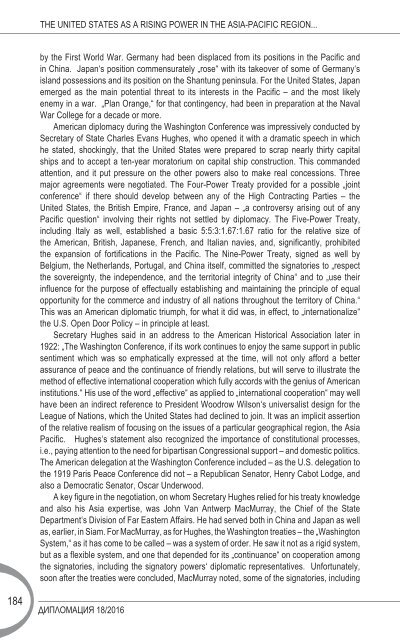DIPLOMACY ДИПЛОМАЦИЯ
2kGfdFv
2kGfdFv
You also want an ePaper? Increase the reach of your titles
YUMPU automatically turns print PDFs into web optimized ePapers that Google loves.
THE UNITED STATES AS A RISING POWER IN THE ASIA-PACIFIC REGION...<br />
by the First World War. Germany had been displaced from its positions in the Pacific and<br />
in China. Japan’s position commensurately “rose” with its takeover of some of Germany’s<br />
island possessions and its position on the Shantung peninsula. For the United States, Japan<br />
emerged as the main potential threat to its interests in the Pacific – and the most likely<br />
enemy in a war. “Plan Orange,” for that contingency, had been in preparation at the Naval<br />
War College for a decade or more.<br />
American diplomacy during the Washington Conference was impressively conducted by<br />
Secretary of State Charles Evans Hughes, who opened it with a dramatic speech in which<br />
he stated, shockingly, that the United States were prepared to scrap nearly thirty capital<br />
ships and to accept a ten-year moratorium on capital ship construction. This commanded<br />
attention, and it put pressure on the other powers also to make real concessions. Three<br />
major agreements were negotiated. The Four-Power Treaty provided for a possible “joint<br />
conference” if there should develop between any of the High Contracting Parties – the<br />
United States, the British Empire, France, and Japan – “a controversy arising out of any<br />
Pacific question” involving their rights not settled by diplomacy. The Five-Power Treaty,<br />
including Italy as well, established a basic 5:5:3:1.67:1.67 ratio for the relative size of<br />
the American, British, Japanese, French, and Italian navies, and, significantly, prohibited<br />
the expansion of fortifications in the Pacific. The Nine-Power Treaty, signed as well by<br />
Belgium, the Netherlands, Portugal, and China itself, committed the signatories to “respect<br />
the sovereignty, the independence, and the territorial integrity of China” and to “use their<br />
influence for the purpose of effectually establishing and maintaining the principle of equal<br />
opportunity for the commerce and industry of all nations throughout the territory of China.”<br />
This was an American diplomatic triumph, for what it did was, in effect, to “internationalize”<br />
the U.S. Open Door Policy – in principle at least.<br />
Secretary Hughes said in an address to the American Historical Association later in<br />
1922: “The Washington Conference, if its work continues to enjoy the same support in public<br />
sentiment which was so emphatically expressed at the time, will not only afford a better<br />
assurance of peace and the continuance of friendly relations, but will serve to illustrate the<br />
method of effective international cooperation which fully accords with the genius of American<br />
institutions.” His use of the word “effective” as applied to “international cooperation” may well<br />
have been an indirect reference to President Woodrow Wilson’s universalist design for the<br />
League of Nations, which the United States had declined to join. It was an implicit assertion<br />
of the relative realism of focusing on the issues of a particular geographical region, the Asia<br />
Pacific. Hughes’s statement also recognized the importance of constitutional processes,<br />
i.e., paying attention to the need for bipartisan Congressional support – and domestic politics.<br />
The American delegation at the Washington Conference included – as the U.S. delegation to<br />
the 1919 Paris Peace Conference did not – a Republican Senator, Henry Cabot Lodge, and<br />
also a Democratic Senator, Oscar Underwood.<br />
A key figure in the negotiation, on whom Secretary Hughes relied for his treaty knowledge<br />
and also his Asia expertise, was John Van Antwerp MacMurray, the Chief of the State<br />
Department’s Division of Far Eastern Affairs. He had served both in China and Japan as well<br />
as, earlier, in Siam. For MacMurray, as for Hughes, the Washington treaties – the “Washington<br />
System,” as it has come to be called – was a system of order. He saw it not as a rigid system,<br />
but as a flexible system, and one that depended for its “continuance” on cooperation among<br />
the signatories, including the signatory powers’ diplomatic representatives. Unfortunately,<br />
soon after the treaties were concluded, MacMurray noted, some of the signatories, including<br />
184<br />
<strong>ДИПЛОМАЦИЯ</strong> 18/2016


